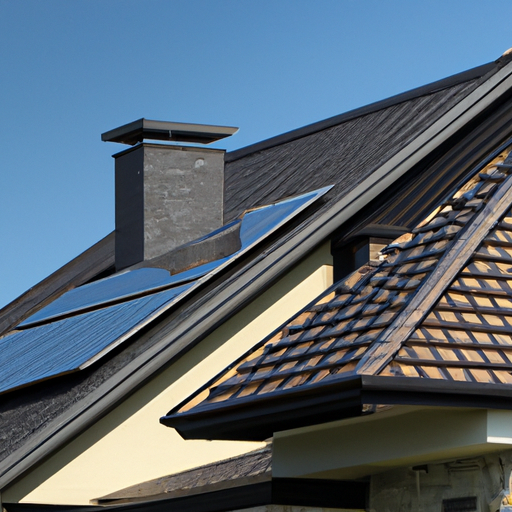Headline 1: Exploring the Latest Innovations in Roof Construction
When it comes to roof construction, there have been significant advancements in recent years that have revolutionized the industry. These innovations not only improve the durability and performance of roofs but also contribute to sustainability efforts. In this article, we will explore some of the latest innovations in roof construction and their potential impact on the future of the industry.
One of the most exciting developments in roof construction is the introduction of green roofs. Green roofs, also known as living roofs, involve the installation of vegetation on the roof surface. Not only do they provide an aesthetically pleasing appearance, but they also offer several practical benefits. Green roofs can help regulate indoor temperature, reduce energy consumption, and manage stormwater runoff. Additionally, they contribute to improving air quality and provide habitats for wildlife in urban areas. With a growing focus on sustainability, green roofs have gained popularity and are expected to become even more prevalent in the coming years.
Another notable innovation in roof construction is the use of solar panels. Solar panels are becoming increasingly common on rooftops as homeowners and businesses recognize the importance of renewable energy sources. Integrating solar panels into roofs not only generates electricity but also helps reduce dependence on traditional energy grids. This technology has steadily improved over the years, with panels becoming more affordable, efficient, and aesthetically pleasing. As the demand for clean energy continues to rise, the integration of solar panels into roof design is expected to become a standard practice.
Advancements in materials have also played a significant role in improving roof construction. The development of more durable and weather-resistant materials has increased the lifespan of roofs. For example, the use of synthetic roofing materials such as rubber and plastic composites has become more prevalent. These materials offer superior resistance to harsh weather conditions, including high winds and heavy rains. Additionally, they are lightweight, making installation easier and reducing the load on the structure. As technology continues to advance, we can expect to see further innovation in roofing materials, leading to even more durable and efficient roofs.
In conclusion, the world of roof construction is constantly evolving with new innovations and trends. The incorporation of green roofs, solar panels, and advanced materials has revolutionized the industry, making roofs more sustainable, energy-efficient, and durable. As we move towards a greener future, it is essential for architects, contractors, and homeowners to stay up-to-date with the latest advancements in roof construction. By embracing these innovations, we can create buildings that are not only functional but also environmentally friendly.
Headline 2: The Growing Importance of Sustainability in Roofing
Sustainability has become increasingly crucial in the roofing industry in recent years. With growing concerns about climate change and environmental impact, there is a strong focus on creating roofs that are not only durable and effective but also eco-friendly.
One of the key aspects of sustainable roofing is the use of environmentally friendly materials. Traditional roofing materials such as asphalt and concrete can have a significant carbon footprint due to the energy-intensive manufacturing processes and the release of greenhouse gases. However, new innovative materials are being developed to minimize this impact.
Recycled materials are gaining popularity in roof construction. For example, recycled rubber from old tires can be used to create durable and weather-resistant roofing tiles. This not only reduces waste but also decreases the consumption of raw materials. Additionally, recycled metal, plastic, and wood can be incorporated into roofing systems, further reducing the need for new resources.
Another important aspect of sustainable roofing is energy efficiency. Roof designs that prioritize energy conservation can significantly reduce the carbon footprint of a building. Techniques such as cool roofing, which uses reflective materials to deflect sunlight and reduce heat absorption, help to lower energy consumption by minimizing the need for air conditioning.
Green roofs are also gaining popularity as a sustainable roofing solution. These roofs are covered with vegetation, providing insulation and reducing stormwater runoff. Green roofs improve air quality, provide habitats for wildlife, and can even help to reduce the urban heat island effect. They are an excellent way to promote biodiversity and create a more sustainable and livable environment.
Additionally, advancements in technology have led to the development of solar roofing systems. These roofs are equipped with photovoltaic panels that generate electricity from the sun’s energy. Solar roofs not only reduce dependency on fossil fuels but also contribute to lower energy costs in the long run. As solar technology continues to improve, solar roofs are becoming more accessible and affordable for homeowners and businesses alike.
Looking ahead, the future of sustainable roofing holds even more promise. Researchers and engineers are continuously working on new materials and technologies to enhance the eco-friendliness and efficiency of roofs. From self-healing materials to smart roofing systems that optimize energy generation and consumption, the possibilities are endless.
In conclusion, sustainability is no longer just a trend but a necessary focus in roof construction. With innovative materials, energy-efficient designs, and technologies such as green and solar roofing, the industry is making great strides towards a more sustainable future. By embracing these advancements, we can not only create roofs that protect our homes but also contribute to protecting our planet.
Headline 3: Future Trends in Roof Construction: What to Expect?
Future Trends in Roof Construction: What to Expect?
As technology continues to advance and sustainability becomes a more significant concern in the construction industry, the future of roof construction is set to undergo some exciting changes. Builders and architects are constantly seeking innovative ways to create more efficient, durable, and environmentally-friendly roofs. In this article, we will explore the future trends in roof construction and what to expect in the coming years.
1. Solar Roofing
One of the most significant advancements in roof construction is the integration of solar panels into roofing materials. Solar roofing allows buildings to harness the power of the sun, generating clean and renewable energy. These solar panels are becoming more aesthetically pleasing, seamlessly blending with traditional roofing materials. As concerns about energy consumption and climate change grow, there is a growing demand for solar roofing solutions.
2. Green Roofing
With an increasing focus on sustainability, green roofing is expected to gain more popularity in the future. Green roofs consist of a layer of vegetation planted on the roof, providing numerous benefits. They help regulate temperature, reduce energy consumption, improve indoor air quality, and promote biodiversity. Additionally, green roofs help manage stormwater runoff, reducing the load on urban drainage systems. As cities become more dense and green spaces scarcer, green roofing offers a practical solution to enhance sustainability.
3. Smart Roofing Systems
In the future, roofs are expected to be equipped with advanced sensors and systems that can monitor and optimize various aspects. This includes sensors that detect leaks, temperature fluctuations, or structural issues, allowing for proactive maintenance and minimizing potential damages. Additionally, smart roofing systems can integrate with other smart home technologies, offering homeowners more control over their energy consumption and comfort levels.
4. Lightweight Materials
Traditionally, roof construction relied on heavy and cumbersome materials. However, advancements in technology have led to the development of lightweight roofing materials that offer the same durability and longevity as their heavier counterparts. Lightweight materials reduce the load on the building’s structure, making construction and installation easier, quicker, and more cost-effective. They also contribute to energy efficiency by reducing the overall weight of the roof.
5. Enhanced Durability and Weather Resistance
With the increasing frequency and intensity of extreme weather events, incorporating enhanced durability and weather resistance into roof construction is crucial. Future roofs are expected to incorporate advanced materials and designs that can withstand high winds, heavy snow loads, and intense heat. This includes improved insulation, impact-resistant materials, and reinforced structures, ensuring that roofs can withstand the harshest of conditions.
In conclusion, the future of roof construction holds immense potential for innovation, sustainability, and improved efficiency. Advancements such as solar roofing, green roofing, smart roofing systems, lightweight materials, and enhanced durability are expected to shape the roofs of tomorrow. As technology continues to evolve, it is essential for builders and architects to stay abreast of these trends to offer their clients the best solutions for their roofing needs.
Headline 4: How Technology is Revolutionizing the Roofing Industry
Technology plays a crucial role in every industry, and the roofing industry is no exception. With advancements in technology, the way roofs are constructed and maintained has significantly transformed. From better safety measures to increased efficiency, technology is revolutionizing the roofing industry in more ways than one.
One of the key ways technology is transforming the roofing industry is by improving the safety of workers. Drones, for example, are now used to inspect roofs and identify potential issues without putting workers at risk. With high-resolution cameras and thermal imaging capabilities, drones can capture detailed images of roofs and help detect leakage or damage. This not only saves time but ensures the safety of workers who would otherwise have to climb up dangerous heights to perform inspections.
Another area where technology is revolutionizing the roofing industry is in sustainability. Green roofing systems, which are designed to minimize environmental impact and maximize energy efficiency, are gaining popularity. These systems incorporate technologies such as solar panels, rainwater harvesting, and green roofs to reduce energy consumption and promote a more sustainable environment. As the world becomes more conscious of climate change and the need for sustainable practices, technology will continue to play a crucial role in developing innovative roofing solutions.
Integration of smart technology is yet another significant advancement in the roofing industry. Smart roofs are equipped with sensors and monitoring systems that can track various factors such as temperature, humidity, and structural integrity. This data can be analyzed in real-time to identify potential issues before they become major problems. By leveraging the power of the Internet of Things (IoT), building owners and roofing professionals can make informed decisions and proactively address maintenance or repair needs, ultimately prolonging the lifespan of the roof.
Looking ahead, the future of technology in the roofing industry appears even more promising. Researchers and engineers are experimenting with new materials and techniques to further enhance the durability, energy efficiency, and overall performance of roofs. For example, self-healing materials are being developed to automatically repair small damages, reducing the need for manual repairs. Additionally, solar roof tiles are becoming more aesthetically pleasing and efficient, allowing homeowners to generate renewable energy without sacrificing the appearance of their homes.
In conclusion, technology is revolutionizing the roofing industry in various ways. From improving worker safety to promoting sustainability and enabling smart roofs, advancements in technology are reshaping the way roofs are constructed and maintained. As technology continues to evolve, we can expect to see even more innovative solutions that enhance the durability, functionality, and sustainability of roofs.



